Type species: Deilephila syriaca Lederer, 1855 (= Clarina syriaca (Lederer, 1855).
A western Palaearctic genus containing two closely related species which, however, are very similar at every stage from the eastern Palaearctic Ampelophaga Bremer & Grey, 1853 (Kawahara et al., 2009). In fact, it is very likely that Clarina kotschyi evolved from an isolated western refuge population of Ampelophaga rubiginosa Bremer & Grey, 1853, which is today confined to India and the eastern Palaearctic.
IMAGO: Distal margin of wings slightly dentate. Pendant lashes at upper edge of eye. Head with a distinct dorsal crest. Long apical spur of mid- and hindtibiae less than half length of the first tarsal segment, which is shorter than the tibia. No comb on midtarsus. Pulvillus small. Paronychium with only one lobe either side. Veins Rs and M1 of hindwing on a short stalk, M2 before centre of cell, lower angle of cell acuminate. D4 less than half length of D3. Very similar to the Oriental genus Ampelophaga and the Nearctic genus Darapsa Walker, 1856.
Genitalia. In male, almost identical to those of the Oriental Ampelophaga rubiginosa Bremer & Grey, 1853, but with the two processes of the phallus slightly thinner, not dentate (Danner, Eitschberger & Surholt, 1998b). Otherwise, valva ladle-shaped; outer friction scales large. Sacculus spatulate and dilated, partly dentate on the upperside. In female, lamella postvaginalis suddenly narrowed, as in Daphnis Hübner, [1819]. Ostium bursae large, free, edges slightly raised.
OVUM: Oval, dorso-ventrally flattened, pale greenish yellow.
LARVA: Typically sphingiform, with the anterior segments retractile into the third thoracic and first abdominal segments. With a series of inverted V-marks down the dorsal surface, one per segment, and a pale, non-ocellate dorso-lateral line. Very similar to that of Ampelophaga and Darapsa.
PUPA: Proboscis fused to body. Brown dotted lines on the wings, legs and antennae. Spiracles set in dark surrounds. Cremaster short and pointed. Very similar to that of Ampelophaga and Darapsa.
HOSTPLANT FAMILY: Vitaceae.
UK: Persian Grape Hawkmoth
Deilephila kotschyi Kollar, [1849], in Kollar & Redtenbacher, Denkschr. Akad. Wiss. Wien 1: 53.Type locality: Schiraz [Shiraz, Iran].
Holarctic; western Palaearctic region. Pleistocene refuge: Monocentric -- Iranian refuge.
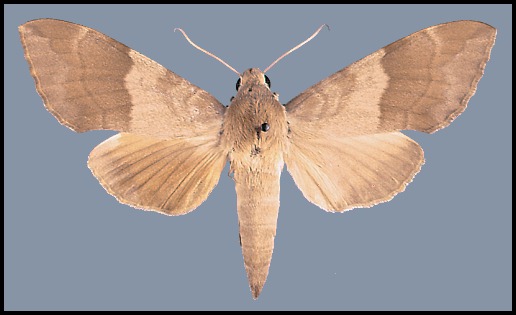
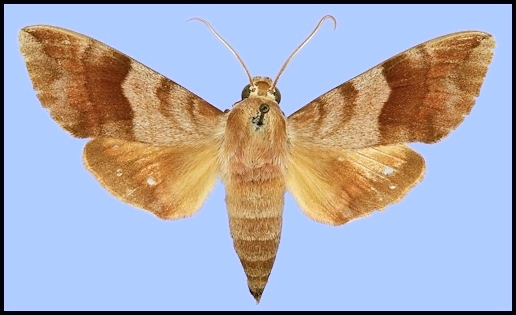
Wingspan: 60--80mm. Much larger than the closely related Clarina syriaca (Lederer, 1855), with slightly different wing pattern and form, i.e. fewer and fainter transverse bands to the forewing and margin less serrate, and small differences in the male genitalia. These differences have been documented by Ebert (1976) and Danner, Eitschberger & Surholt (1998b). Wing coloration very variable, ranging from reddish brown to pale grey with a brown suffusion (Ebert, 1976). In central Turkey and northern Iraq intermediate forms with Clarina syriaca can be found where both species come into contact. These post-glacial zones of secondary contact and hybridization between once isolated sister species are known as suture zones, and have been reported for a variety of taxa in many biomes (Barrowclough et al., 2019; Ipekdal et al., 2020; Moritz et al., 2009; Portnoy & Gold, 2012).
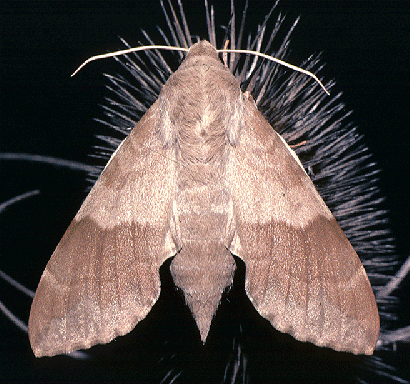
Rests by day amongst the dense foliage of its hostplant, or on rocks on the ground. At dusk, even those individuals that have emerged that afternoon take flight and, for a short period, go in search of nectar-bearing flowers.
Local in central Iran on hillsides up to 2000m and in mountain valleys with shrubs, vineyards and isolated trees. Can be very common in some grape-growing areas.
Trivoltine; early May to late August in three overlapping generations.
OVUM: Oval (1.50 x 1.25mm), pale yellowish green, often containing a distinct bubble of air; very similar to that of Mimas tiliae (Linnaeus, 1758). Laid singly on both the upper and lower leaf-surface of its hostplant, with preference shown for Vitis shrubs growing on the edge of gorges, in plantation corners or in gardens (Pittaway, 1982b).
LARVA: Full-fed 55--70mm. Initially 3--4mm long, pale yellow, cylindrical, with a black, straight, almost upright horn 1.25mm in length. With feeding, it becomes yellowish green. In the second instar, pink replaces black on the horn and the final pattern appears, i.e. a yellow, dorso-lateral line from over the head to the horn, yellow body spots and a dorsal inverted V-mark on each segment. In the final instar, further changes occur: the third thoracic and first abdominal segments become slightly inflated so that, when alarmed, the small head and first two thoracic segments can be retracted into them. A grey-blue tint suffuses the basic green colour below the dorso-lateral line and a narrow, ventro-lateral streak appears above the thoracic legs.
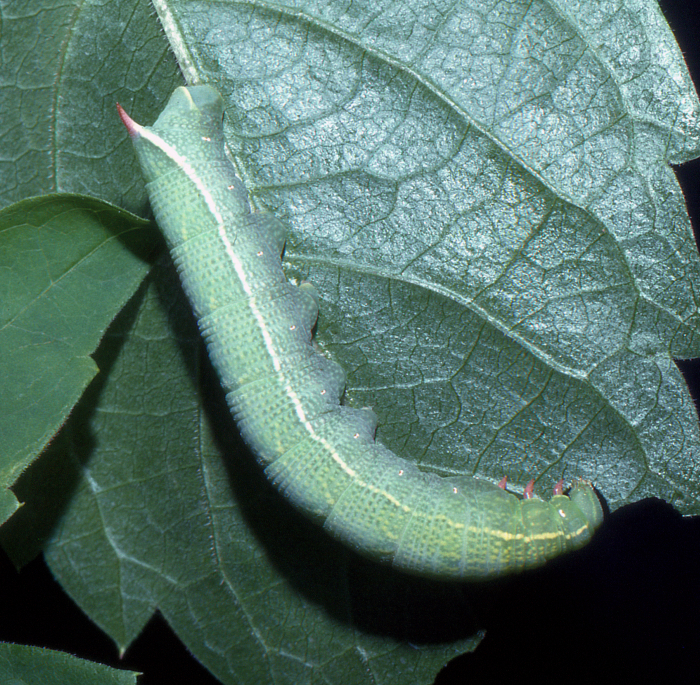
At all stages of development, the larva rests stretched out along the midrib on the lower surface of a leaf, rarely exposing more than its head and first two segments when feeding. In fact, the larva is very secretive and will hide at every opportunity. When moving, it does so in a slow, measured, jerky fashion. It feeds constantly and, by the time it is fully grown, large quantities of food have been consumed (Pittaway, 1982b).
Prior to pupation, the larva anoints itself with 'saliva' and becomes reddish brown before descending from its hostplant under the cover of darkness.
Found from early May to September, often with many stages of development present together.
Hostplants. Vitis vinifera, Parthenocissus spp. and Ampelopsis spp.
PUPA: 35--48mm. Similar to that of Daphnis nerii (Linnaeus, 1758). The wings are translucent brown, with the veins marked out with lines of dark brown spots. As in Daphnis nerii, a crescent-shaped mark partly encircles each eye and the spiracles are set in dark surrounds. Formed in a loosely spun cocoon of light brown silk amongst debris and stones at the base of a rock or a grass tussock. The overwintering stage.
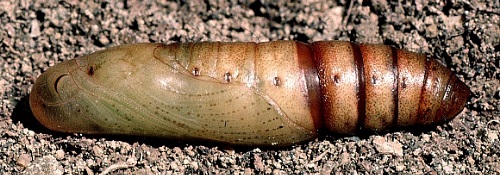

None recorded.
The Iranian plateau (Brandt, 1938; Barou, 1967; Ebert, 1976; Ghassemi, Alemansoor & Alehossein, 2010) and Mesopotamia (Wiltshire, 1957) to southeastern Turkey (Danner, Eitschberger & Surholt, 1998; Seven, 2020; Kemal & Koçak, 2012; Kemal & Koçak, 2016; Kemal & Koçak, 2018; Koçak & Kemal, 2018; Seven & Çakir, 2019). In eastern-southern Turkey, Clarina kotschyi forms a clinal hybrid population with C. syriaca. These post-glacial zones of secondary contact and hybridization between once isolated sister species are known as suture zones, and have been reported for a variety of taxa in many biomes (Barrowclough et al., 2019; Ipekdal et al., 2020; Moritz et al., 2009; Portnoy & Gold, 2012).
Extra-limital range. None.
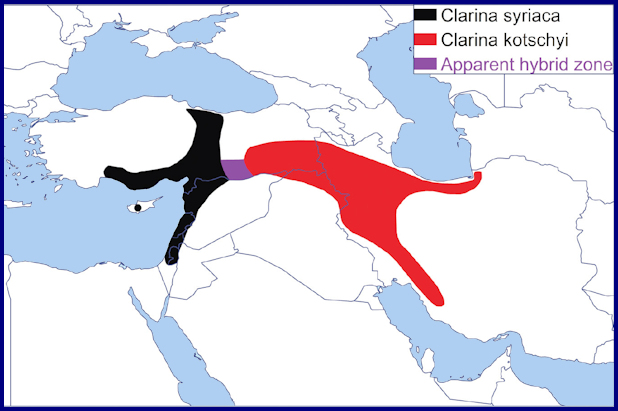
Map: Map showing the estimated distributional range of Clarina syriaca (black), Clarina kotschyi (red), and an apparent hybrid zone (purple) between the two species (© Aristophanous, Pittaway & Aristophanous, 2022).
None. In central and southern Turkey, and the Levant, it is replaced by the closely related Clarina syriaca.
 Return to species list
Return to species list